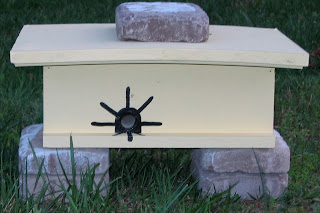There are a number of web sites out there listing alternative pollinators I've found recently. A number of friends and colleagues have asked about colony collapse, the news coverage has been quite valuable in having people think about the value and importance of bees in pollination. But, as a beekeeper, it's sometimes easy to forget that there are other pollinators - and that in countries like the U.S. the honey bee is not native and it's introduction has suppressed a number of native pollinators.
The kids love the new Bumble Bee house, but there are kits for Mason Bee
Wednesday, April 16, 2008
Pollinator links
Interesting bottom board "muck"
I took some pictures when I took the plastic board out from under the hive after the winter. The board had a pretty good covering of "muck" which I decided to have a good look at before I cleaned it up and put it away for the spring/summer. I found a bunch of interesting stuff, remains from the Api Life mite treatment, pollen, some dead mites, a bee leg or two and wax flakes. The picture below shows some of this, the green fluffy stuff is Api Life, the yellow and orange blobs are pollen - but the things that fascinated me are the neat round brown seeds. They seem to be millet seed, and indeed some were even starting to sprout - but where did they come from? I wondered if there had been a mouse or something in the hive over winter but I could see no evidence. Right now it remains a mystery :-)
The next photo was more interesting to the kids (and me), it shows the wax flakes the bees produce as well as a few bee body parts.
New bee "home"
Last time we had my parents visit my father built a Bumble Bee house (plans from xerxes.org) which we painted and put out a week or so ago. I got a (poor) picture, and thought it should be up here among the more common bee home/hive pictures :-)
It's kind of hard to get a feeling for size, but the grass along the bottom gives some idea.
Wednesday, April 9, 2008
New packages ordered
At the end of the year I ordered two more packages from Rossman, due on April 30th, so have to get busy. I brought in a truck full of mulch to finish off the bee yard, the last lot (laid over weed fabric) was successful in keeping the weeds and poison ivy at bay. This gave me a whole lot more space and I put out some concrete blocks ready for new hives. I'd like to keep the hives close-to eventually but need to check on an appropriate distance to start them off at (any ideas anyone?)
I have one Brushy Mountain hive ready painted from last years adventures so that's all ready to go, and hoping I can get another in shape before they arrive - if not then I guess it's the nuc for a temporary home.
I'll see if I can get some pictures of the yard together, I did take some of the board from the IPM screened bottom, it had an interesting collection of things stuck to it from the cold weather.
Back after the winter
Interestingly, I was writing a post this morning and even had it saved as a draft when the kids came in all excited that "the bees are swarming!". So, here's the text of this post as it was this afternoon:
Well, everything survived the winter, which given NC weather isn't too extreme. We luckily didn't suffer an Easter freeze and so everything seems set. I have yet to go and check them thoroughly and reverse the boxes, but the weather is turning nice now after a week of grey and rain so should be able to soon. I have checked on them a couple of times briefly in the winter and everything looked good and all the signs are we should be building up nicely.So apparently the bees had their own idea of when I should be paying attention to them. There's been a lot of discussion on the Chatham Beekeepers mailing list about swarms in the area and so it was a definite possibility, but looking out of the window on the way down there was certainly a lot of bees on the front but not that many. So, just in case, I dug out my nuc, grabbed my stuff and headed down. Even before I got there things had calmed down so I assumed it was the warm day (we hit mid 70's here) and the fact that the last week had been cold, wet and overcast.
So I decided to take the plunge and go through the hive and give it a good check. I had on my usual hat and shirtsleeves but the tone of the hive soon had me decide that perhaps a veil was a better idea. There was a lot of angry flying about, in the end nothing too aggressive but better safe than stung. I took away the top feeder which is clearly not necessary now as all the three boxes on there were nicely in use. I rotated the boxes, the top two were well stuck together with burr comb which I removed the best I could. The bottom box was clearly less used but certainly not empty and I noticed new healthy looking brood on a number of frames.
My smoker played up again, so the whole thing took longer than I would have liked and so I didn't go through each frame (would have been good to check for swarm signs just in case) but maybe next time.
Was nice to be back among them, even on their more "busy" days it's still fun to be surrounded by them.
